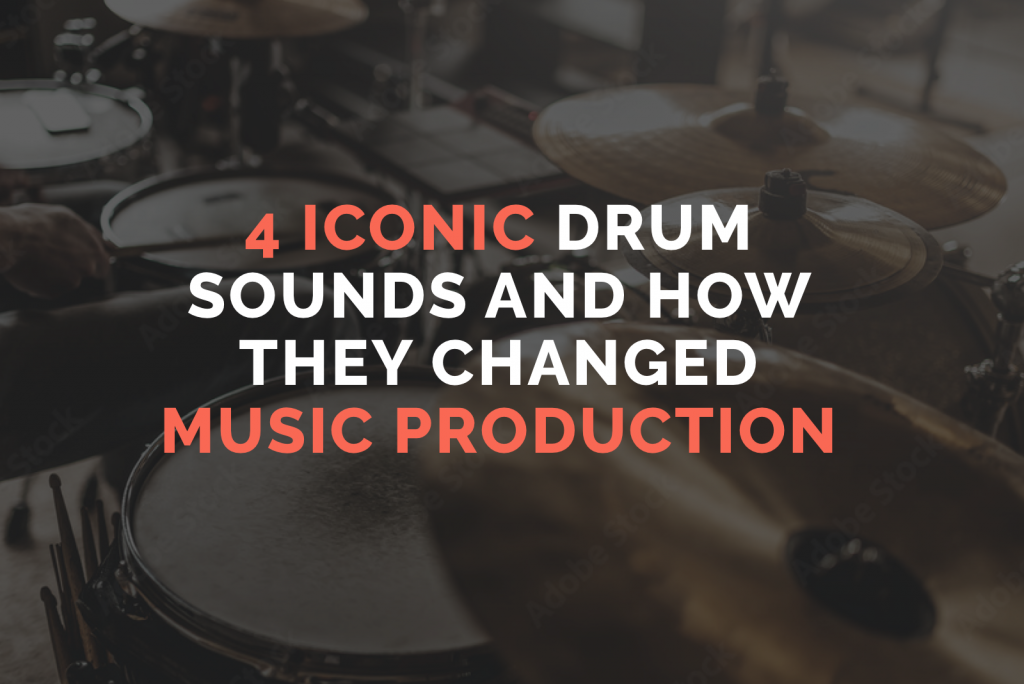4 Iconic Drum Sounds And How They Changed Music Production
Throughout music history, drummers and engineers have come along that revolutionize the sound of the drums. As time moves on these sounds never go away, but they become reused and rethought in different ways and become a feature of the music production moving forward. In this post I dive into what are in my opinion the 3 most iconic drum sounds, where they came from, how they evolved, how they are achieved, where they fit into modern music, and can shape the way you think and plan about the drum recording and mixing in your songs.
This is a guest post by top rated AirGigs session drummer, producer and mixing engineer Luke O’Kelley
1) 60’s Big Roomy Rock
Source: Led Zeppelin’s John Bonham “When The Levee Breaks”
This sound is what most people think of when they hear “big rock drums.” John Bonham is one of the most influential rock drummers in history, and Andy Johns (the engineer on “When The Levee Breaks”) is one of the most influential engineers in history.
“When The Levee Breaks” has a distinctive delay on the drums that supports the groove. John Bonham is known for playing huge drums tuned relatively high, and hitting really hard. In general his drums are recorded without muffling in large spaces. Pretty much all of Led Zeppelin’s songs feature this iconic big roomy drum sound. On this particular song, the drums were recorded with two Beyerdynamic M160 microphones used as room mics, placed far away from the drums in a large room with lots of compression and delay on them.
Here’s a video by Rick Beato showing how the sound was achieved and dispelling some common myths around it:
Modern Example: Foo Fighters’ Dave Grohl “My Hero”
Like all the sounds I’ll mention, it didn’t die out in the 60’s, but has gone onto to be a sound that influences drum recording and production techniques to this day. A more modern example of this drum sound can be heard on the iconic Foo Fighters track “My Hero.”
In “When The Levee Breaks” the engineer adds to the roominess of the drums with delay, but in “My Hero” the drums are actually two different drum takes ontop of each other: one tracked in a really big room and one was in a tighter, smaller room. Here’s a video of Warren Huart talking to the engineer of the song, Bradley Cook about the process of making the song:
2) 60’s-70’s Muffled/Dead Drums
The 60’s weren’t just the start of big/boomy sounding drums, but also where we can first hear the “dead” drum sound start to take shape. Ringo Starr is famous for putting tea towels on his drums to muffle the resonance of the drum heads. It allows for the drums to have less overtones and ring, making them warmer, punchier, and overall easier to control in a mix.
Source: The Beatles’ Ringo Starr Abbey Road album
Modern Example: Little Yachty “the BLACK seminole”
This iconic drum sound went on to be the defining drum sound of the 70’s, heard in songs like Fleetwood Mac’s song “Dreams.” It also turned into the defining drum sound of the disco era.
This drum sound has become extremely trendy in recent years.
3) 70’s Tight & Funky
This drum sound is similar to the muffled/dead drum sound, but the drums (especially the snare) are less muffled, higher pitched, and cut through the mix more.
Source: James Brown’s “Funky Drummer”
This song is often cited as having the most sampled drum groove in history. In the early era of hip hop, drummer Clyde Stubblefield’s drum break was sampled in numerous songs cementing this drum sound as an iconic influence on music production still today.
Modern Example: Bruno Mars’ “Perm”
4) 80’s Gated Reverb
Phil Collins infamous drum sound was discovered by engineer Hugh Pagham while Phil was recording drums for a Peter Gabriel album. Hugh had the highly compressed reverse talkback mic turned on on his SSL 4000 mixing board while Phil was playing and was intrigued by the sound. Hugh was later on the engineer on Phil Collins debut album “Face Value” featuring “In The Air Tonight” where they recreated that sound.
Source: Phil Collins “In The Air Tonight”
Modern Example: Kid Cudi “Erase Me”
This drum sound is similar to the big roomy rock sound in that you can hear a lot of reverb and room ambience, but different in that the gate shuts off the reverb tale prematurely giving the drums an unnatural sound. You can hear that the drums on “In The Air Tonight” have a shorter reverb tale while the snare drum in the intro and choruses of “Erase Me” have a longer reverb tale that cuts off right before the next snare hit.
Just like all these other drum sounds, there’s lots of different colors and methods for how this sound has been implemented over the years by different artists.
Conclusion
There’s a lot that goes into capturing a great drum sound, from the drummer, the sticks, instrument, room, mics, preamps, effects and processing, there are lots of ways to skin the cat. The sheer number of possibilities can sometimes lead to paralysis by analysis. Understanding some of the most iconic drum sounds, where they came from, how they were achieved, and how they’ve gone on to influence production decisions over the years can make it easier to look at your songs and think about what kind of drum sound might fit your song the best.
Understanding what drum sound your song needs and communicating your vision and direction to a drummer will help them to get the right drum sound during the recording process so that you don’t have to completely reinvent the drum sound during the mixing process.
There’s a lot of different drum sounds that have influenced music production through the years. What are some of your favorite drum sounds?

